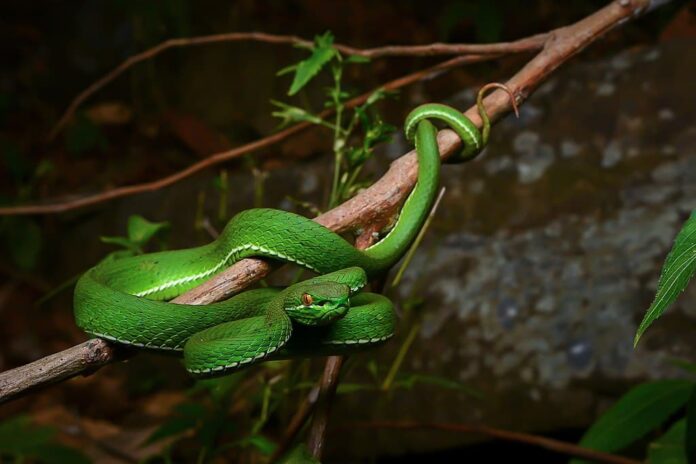We enjoy the view of colorful things like rainbows and flowers, but things should go differently with colorful snakes. Brightly colored snakes are indeed beautiful; however, the colors are also the signs telling us that they are dangerous. The part that we can’t deny is that some of these venomous colorful snakes are so gorgeous to look at. Yet once you get near them, the beauty you adore can turn into your worst nightmare with just one strike. In case you want to know which venomous colorful snakes, take a look at the list below.
1Banded Krait
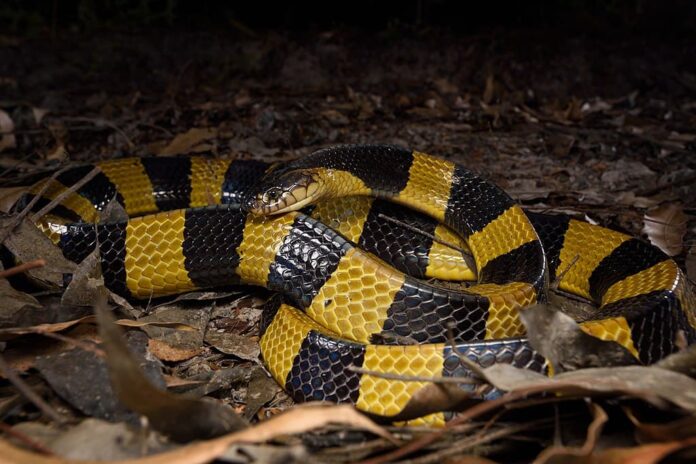
Habitat: Indian Subcontinent, Southeast Asia
With a maximum length of up to 2.1 meters, this krait is one of the largest and most dangerous kraits. You can easily identify them by their black and yellow crossbands as well as the triangular body cross-section. These kraits are common across Southeast Asia in a variety of habitats ranging from forests to agricultural lands. Most of the time, banded kraits are shy and slow during the day, and they are not interested in striking at all.
Bites usually occur at night, and these snakes tend to be more aggressive and dangerous when the sun goes down. When bitten, the victims are likely to experience effects such as vomiting, abdominal pain, diarrhea, and dizziness. In severe cases, the envenomation can lead to respiratory failure while death may occur due to suffocation. A polyvalent antivenom to this snake is only available in India at the moment.
2Blue Malaysian Coral Snake
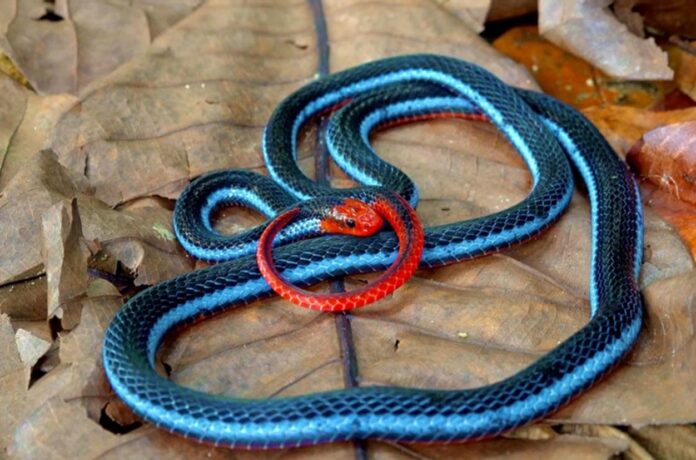
Habitat: Southeast Asia
This species is a venomous elapid as well as one of the most beautiful and colorful snakes. The snake has a red coloration on its head, tail, and belly while the back is dark blue or black. Usually, they also have a large blue or white stripe on each flank as well. This species prefers to live and forage in and under as well as on top of leaves and fallen trees and rocks. Normally, they always avoid people and other large threats, and they can be very fast as they flip about almost spastically.
There have been many people who free-handled these snakes without realizing how lethal their venom can be. The unique thing about their venom is that it does not contain neurotoxins like other snakes at all. Their venom consists of cytotoxin that leads to the destruction of muscle tissue or promotes the release of adenosine. That can cause hypotension, inflammation, and neurotransmitter blockade in victims after the bite. The victim may die as fast as within 5 minutes of envenomation, so make sure to not touch such a deadly snake.
3Boomslang
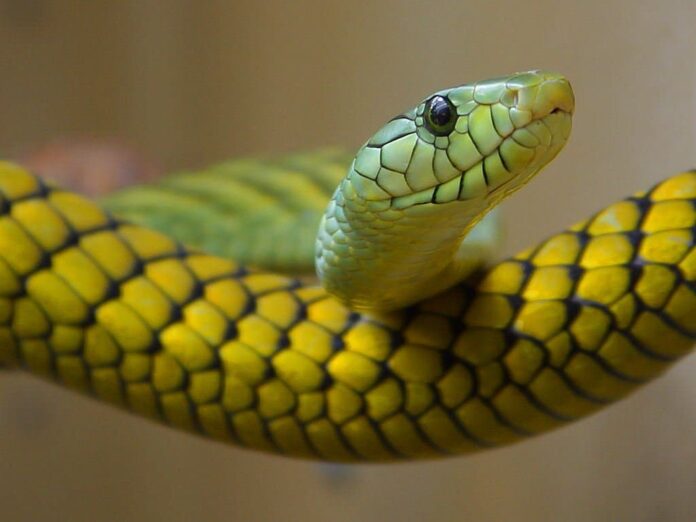
Habitat: Africa
Boomslang is a perfect example of the phrase that says “never trust a pretty face”. This is a large snake species that is swift, agile, and of course, venomous. The good part about them is that they are shy and non-aggressive so they don’t attack humans out of the blue at all. Their name means “tree snake” in Dutch and Afrikaans, and that is where they live. Boomslangs spend most of their time chilling out in trees in a variety of environments mainly from coastal thickness to savannahs.
Just like most venomous colorful snakes, this one also displays its bright colors as well. The coloration of a boomslang ranges from green and yellow to pinkish red, and they look super cute. Plus with their stunning large eyes, boomslangs are one of the most beautiful snakes in the world. However, such beauty can mess you up with just one bite. The venom of a boomslang contains hemotoxic which destroys red blood cells, disrupts the clotting process, and causes tissue and organ degeneration.
The first stage of the bite could be a headache, nausea, and sleepiness before things move on to the next stage. Then the victim will experience hemorrhage ensues which causes them to bleed from their gums. Sometimes, the body of the victims will also turn blue because of the widespread internal bleeding. The process can be slow and take as long as five days until the victims die of internal bleeding. The good thing is that antivenom is available, and boomslangs don’t usually attack humans first at all.
4Eyelash Viper
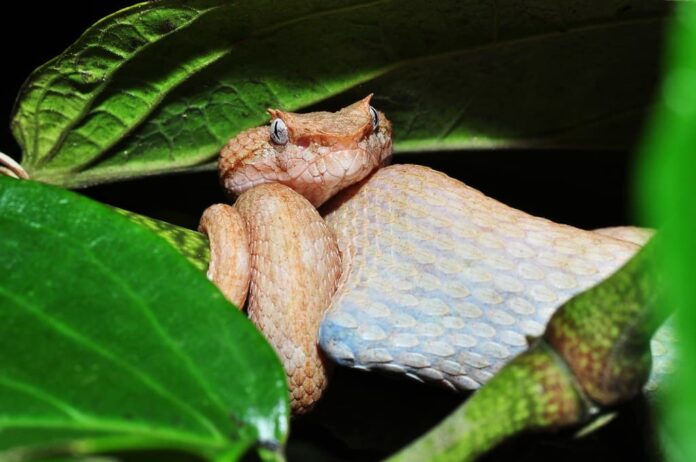
Habitat: Central America, South America
I don’t know about you, but I would totally adopt this viper if it was not so venomous and deadly. The name already suggests the main beauty of this serpent, its beautiful unique set of scales that resembles eyelashes. But don’t let this stunning appearance trick you because eyelash vipers are also famous for their aggression and lightning-fast strikes. Their colors range from red, yellow, brown, green, and pink to various combinations of many other colors. Such bright colors help them to camouflage in bushes, berries, and fruits easily. Their habitats are tropical rainforests, wooded cloud and montane forests, dense sea-level forests, and streamside vegetation in lowlands and foothills.
They often spend most of their lives in trees, palms, shrubs, and vines, and they prefer to stay near a permanent water source. The eyelash viper is an ambush predator, and they wander alone as they hunt at night. These snakes can wait for hours before they unleash a lightning-fast attack and inject lethal hemotoxic venom. The venom affects both the cardiovascular system and the central nervous system which is highly toxic and fatal.
Eyelash vipers inject the venom using their 2 extremely long fangs on the upper jaw. The bite can cause severe pain, swelling, bruising, bleb formation, and very often necrosis. If the victims don’t treat the wound on time, it can lead to loss of a limb or even worse, death.
5Green Bush Viper
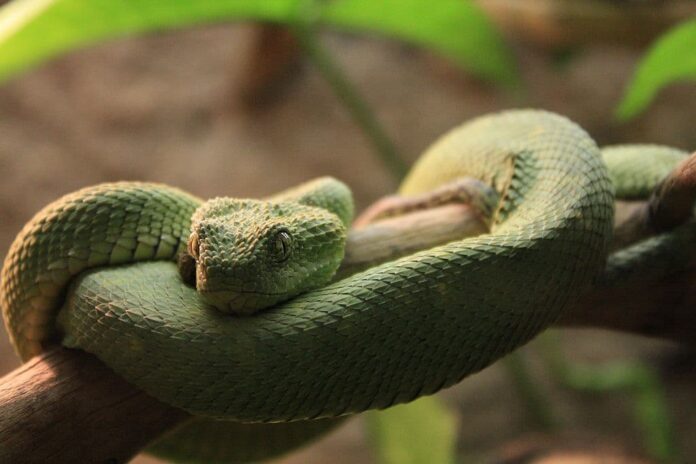
Habitat: West Africa, Central Africa
Being one of the most beautiful snakes, green bush vipers look undeniably majestic. With the combination of the compressed body with strongly keeled scales and bright colors, this viper species is definitely the real beauty. Their coloration is yellowish-green on the dorsum and venter which helps them to camouflage in their natural habitat. Most of the time though, their colors are sage green, light green, green, dark green, bluish, olive, or dark olive-brown. Usually, these beautiful vipers prefer to live in tropical forests and areas with dense vegetation where small rodents and preys are abundant.
These ambush predators, love to strike their prey very rapidly with speeds recorded in milliseconds. Things go differently when they defend themselves against predators like other animals with humans. When threatened, the viper will extend its body and raise the anterior portion of its body into the air. The settlement into a striking position is to ward off predators, and it works most of the time. The venom of this species is potent, and there have been death reports from their bites as well. The good thing is the antivenom to this species is available, so that’s better to know.
6Sri Lankan Pit Viper
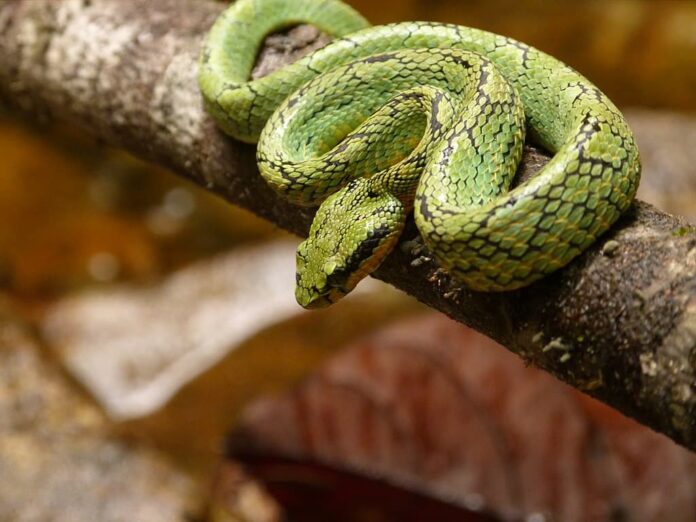
Habitat: Sri Lanka
With the combination of light greenish-yellow, this species is one of the most colorful snakes in Sri Lanka. The unique thing about them is that they have two or three large supraocular scales which make them even more beautiful. You can find them in all three climatic zones of the island except higher hills and arid zones. These adorable snakes love to live in wet zone grasslands and rainforest areas, especially in plantations of cardamom, cocoa, coffee, and tea.
People are likely to encounter them in the morning as the snakes stay on top of trees to obtain sun rays to heat their bodies. This species is not aggressive, but they will not hesitate to bite if agitated. Their method is by vibrating their tail tip to form a sinuous loop with the forebody then lash to attempt to bite. Although their venom is primarily haemotoxic, victims still experience severe pain and swelling in the bitten area. The pain of the wound may last for a few days, but there is no report of fatalities so far.
7Wagler’s Viper
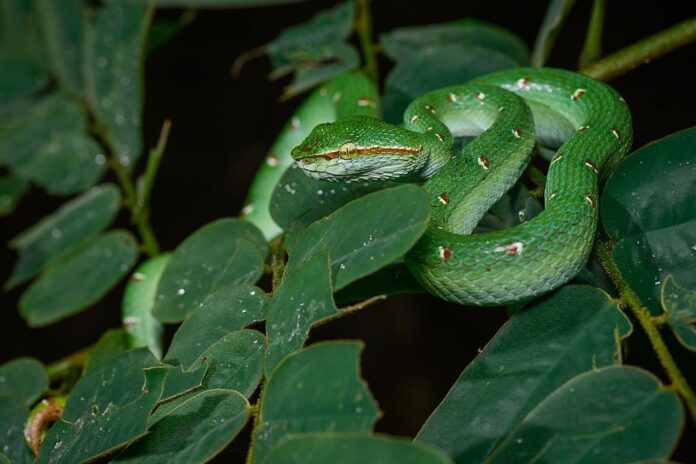
Habitat: Southeast Asia
Also known as Temple Viper because of its abundance around the Temple of the Azure Cloud in Malaysia, this species is also venomous. Wagler’s vipers come in a wide variety of bright beautiful colors and patterns which are known as phases. These snakes inhabit various places in Southeast Asia mainly in lowland forests as well as some coastal regions. If you ask how dangerous are they, the rate would be 7 out of 10 mainly because of their speed.
These vipers can strike very quickly both on their prey and predators, but they are not aggressive at all. You can easily notice them by their scary and markedly triangular head as well as their bright color. In case you want to see them in real life, you may take a trip to the Snake Temple in Penang, Malaysia. The temple is a plethora of free-roaming snakes, most of which are Wagler’s Vipers. It is said that the snakes eat so much at night they are too exhausted to do anything during the day. So you will be safe once you’re at the temple because the worshippers offer food at this temple every day.
8White-Lipped Pit Viper
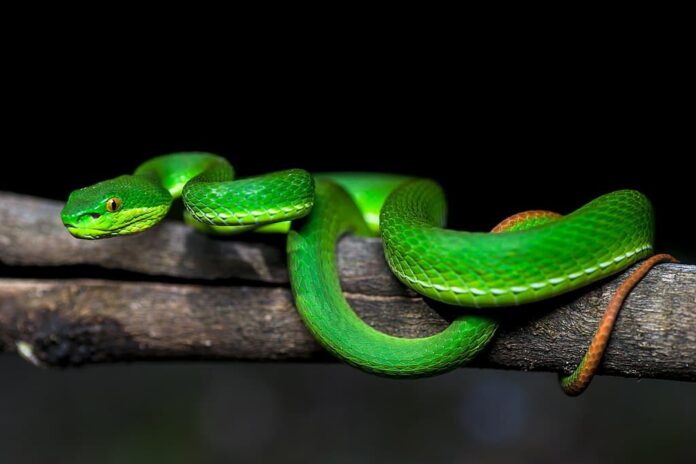
Habitat: Southeast Asia
The combination of green and yellow makes this white-lipped pit viper one outstanding-beauty serpent in the snake kingdom. Just like most green pit vipers, you can easily find them anytime during the day but they are active in the dark. These vipers usually live in growth mixed dry deciduous forests and narrow stripes of vegetation along roadsides. The unique thing about them apart from their color is that the green vipers’ bodies seem to light up when you flashlight them. Another distinctive part of these vipers is their large yellow eyes which make them even more beautiful. This viper species is not aggressive, but its venom effect ranges from mild to death because it contains procoagulant properties. If not treated on time, the results can be severe or fatal.
9Yellow Bellied Sea Snake
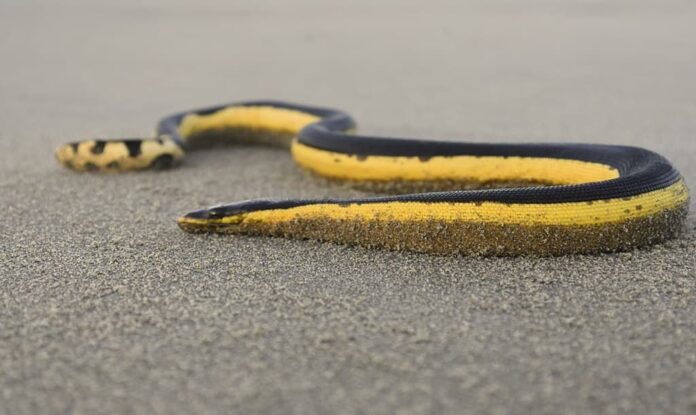
Habitat: Coasts of Indo-Pacific, Atlantic Ocean
A list of deadly snakes would be incomplete without the presence of the yellow-bellied sea snakes. These venomous snakes are one of the most widely distributed snakes in the world, and that’s bad news because they are dangerous. This snake species is very easy to notice because they have bright yellow bellies with dark gray bodies. Since they are good swimmers, it is not a surprise to see them out of their native range. The cool part is that they can survive severe dehydration for up to 7 months during seasonal drought. As for their venom, it is highly potent it can cause damage to the skeletal muscle which leads to death. So basically these snakes are colorful, venomous, and tough which is a dangerous combination of a serpent.
Related Post: Extremely Dangerous Snakes

